.
18.04.2015
.
COMETWATCH 15 APRIL
Today's CometWatch entry is a single frame NAVCAM image obtained on 15 April, from a distance of 170 km from the centre of Comet 67P/Churyumov-Gerasimenko. At this distance, the resolution is 14.5 m/pixel; the image has been cropped to 11.4 km (the original frame, provided at the end of the post, measures 14.8 km across).
.

Cropped and processed single frame NAVCAM image of Comet 67P/C-G taken on 15 April 2015 from a distance of 170 km to the comet centre. Credits: ESA/Rosetta/NAVCAM – CC BY-SA IGO 3.0
.
Like CometWatch 9 March and 22 March, today's entry shows 67P/C-G from an unusual angle, revealing some regions on the comet nucleus that in previously published images were partly cast in shadow.
In this orientation, the small comet lobe is on the left, and the large one on the right. The image has been processed to bring out the comet’s activity, showing majestic jets of material emanating from 67P/C-G. Parts of both lobes are visible, in the lower half of the image, as dark silhouettes against the diffuse glow that envelops the nucleus.
The large circular depression on the small lobe is Hatmehit and, to its right, parts of the Bastet region are visible. The large lobe provides an interesting view on the Aker region (the bright-looking portion pointing upwards in this orientation) and on the rough terrains of Khepry (to the right).
The original 1024 x 1024 image is provided below:
.
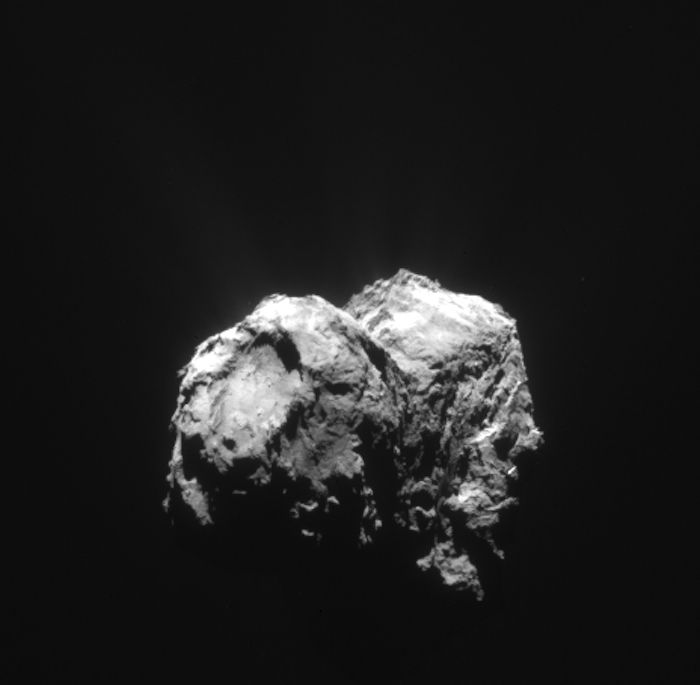
Quelle: ESA
.
Update: 20.04.2015
.
Geheimnisvoller Staubstrahl am Kometen Churyumov-Gerasimenko

Kometen schleudern Gas und Staub in den Weltraum. Das geschieht vorwiegend an sonnenbeschienenen Stellen der Kometenoberfläche. Nun hat die OSIRIS-Kamera auf der Rosetta-Mission zufällig ein außergewöhnliches Phänomen am Kometen 67P/Churyumov-Gerasimenko in Bildern festgehalten. Auf der Schattenseite des Kometen zeigte sich Mitte März bei Aufnahmen aus 75 Kilometern Entfernung plötzlich ein neuer Staubstrahl, dessen Ursache bisher ungeklärt ist. "Zum ersten Mal wurde dabei auch direkt der Moment der Geburt eines neuen Staubstrahls beobachtet", sagt Kometenforscher Dr. Ekkehard Kührt, der die wissenschaftlichen Beteiligungen des Deutschen Zentrums für Luft- und Raumfahrt (DLR) an der ESA-Mission Rosetta leitet. "Diese Beobachtungen werden helfen, die bisher nicht vollständig verstandene kometare Aktivität zu entschlüsseln."
Kraft der Sonne
Über die vergangenen Wochen hat sich die Aktivität des Kometen 67P/Churyumov-Gerasimenko kontinuierlich verstärkt. Durch seine weitere Annäherung an die Sonne, heizt sich die Oberfläche auf, so dass zunehmend Gas in den umgebenden Weltraum austritt und Staubpartikel mit sich reißt. Rund vier Monate sind es noch bis zur größten Annäherung an die Sonne, doch bereits jetzt ist Churyumov-Gerasimenko von einer Kometenkoma umgeben. Überall auf der Tagseite ist deutlich zu erkennen, wie Staub entweicht.
Der nun entdeckte Staubstrahl auf der Schattenseite des Kometen stellt die Wissenschaftler vor ganz neue Fragen. "Es ist schon sehr spannend darüber nachzudenken, wie denn Kometen auch auf der Schattenseite aktiv werden können", sagt Dr. Jörg Knollenberg, DLR-Kometenforscher und Wissenschaftler im OSIRIS-Team. "Allerdings ist es gut möglich, dass erste Sonnenstrahlen auf bisher im Schatten versteckte Bergklippen fielen. Es sind weitere Beobachtungen und Berechnungen notwendig, um hier eine plausible Antwort zu finden", so Knollenberg weiter.
Staubausbreitung mit acht Metern pro Sekunde
Die einmalige Beobachtung gibt den Wissenschaftlern auch Gelegenheit, die Staub-Ausbreitungsprozesse besser zu studieren. "Wir analysierten die Helligkeitsschwankungen entlang des unerwarteten Staubstrahls und konnten dabei abschätzen, dass sich die Partikel mit mindestens acht Metern pro Sekunde vom Kometen entfernen", erklärt Knollenberg. Damit bestätigten sich vorangegangene Messungen zur Staubausbreitung auf der Tagseite.
Die Mission
Rosetta ist eine Mission der ESA mit Beiträgen von ihren Mitgliedsstaaten und der NASA. Rosettas Lander Philae wird von einem Konsortium unter der Leitung von DLR, MPS, CNES und ASI beigesteuert.
Quelle: DLR
-
Update: 23.00 MESZ
-
OSIRIS CATCHES ACTIVITY IN THE ACT
Rosetta’s scientific imaging system OSIRIS has witnessed a new jet of dust emerging from the surface of Comet 67P/Churyumov-Gerasimenko. The image was presented during the European Geosciences Union General Assembly, EGU, in Vienna last week.
Sometimes it is all a matter of being in the right place at the right time. Or, as in the case of ESA’s space probe Rosetta, of opening your eyes at the exactly right moment. In mid-March, the OSIRIS camera was able to catch the elusive moment when a new dust jet from comet 67P/C-G burst into life.
.
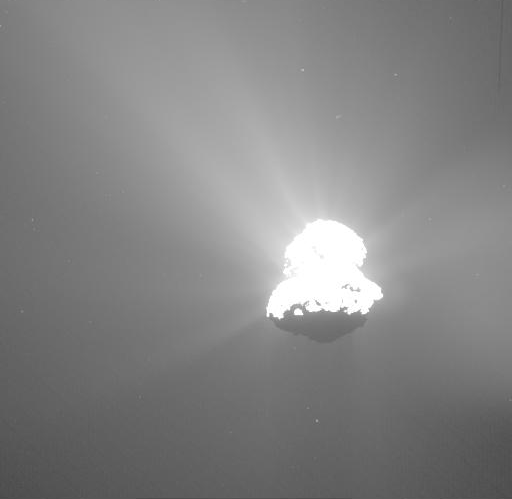
Rosetta’s OSIRIS wide-angle camera captures the moment a jet bursts into action. The first image was captured at 07:13 CET on 12 March 2015, the second two minutes later. Credits: ESA/Rosetta/MPS for OSIRIS Team MPS/UPD/LAM/IAA/SSO/INTA/UPM/DASP/IDA
.
The comet’s activity has been significantly increasing over the last weeks and months. As the comet moves closer to the Sun along its orbit, its nucleus gets warmer and warmer. Frozen gases sublimate from its surface, carrying dust particles with it and enshrouding the nucleus in a dense coma. With only four months to go until perihelion – the closest point to the Sun – this process is well underway, with pronounced dust jets seen at all times on the comet’s day side.
.

The scene at 07:13 CET on 12 March. Credits: ESA/Rosetta/MPS for OSIRIS Team MPS/UPD/LAM/IAA/SSO/INTA/UPM/DASP/IDA
.
The two images released today show the remarkable onset of such a jet for the first time. They were taken on 12 March from a distance of 75 kilometres. In the first image, obtained at 07:13 CET, several rays of dust jets frame the upper, illuminated side of the comet. The dark underside shows no such features. Two minutes later, the picture has changed: a spectacular new jet has emerged on the dark side, hurtling dust into space and displaying a clearly discernable fine structure.
“This was a chance discovery,” says OSIRIS principal investigator Holger Sierks from the Max Planck Institute for Solar System Research (MPS) in Germany. “No one has ever witnessed the wake-up of a dust jet before. It is impossible to plan such an image.”
Tracking variations in brightness along the jet, the researchers estimated the velocity of the dust grains to be at least eight metres per second. This is compatible with measurements made with Rosetta’s GIADA instrument on other occasions, for dust particles emitted from the comet’s surface.
Surprisingly, the new-born jet arises from a shadowed area on the underside of the comet, close to the centre of the Imhotep region. So far cometary activity has only been observed on the comet’s day-side.
.
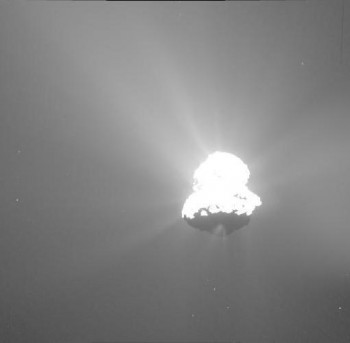
The scene at 07:15 CET on 12 March. Credits: ESA/Rosetta/MPS for OSIRIS Team MPS/UPD/LAM/IAA/SSO/INTA/UPM/DASP/IDA
.
“In these images we see Imhotep on the brink of dawn,” OSIRIS scientist Jean-Baptiste Vincent from the MPS explains. “It is possible that the first rays of sunlight hit some cliffs or outcrops that remained hidden to Rosetta due to the orbital position at the time.”
The onset of activity could also be the result of a different type of more explosive activity. That is, the outburst could have been triggered by a wave of heat reaching ices trapped in a deeper layer beneath the surface.
OSIRIS could not continue to observe the new feature after 07:17 CET because Imhotep was soon fully illuminated, making it impossible to discern individual jets in the overexposed coma. It is therefore not clear whether Rosetta witnessed the birth of a continuous jet or a short-lived outburst.
“Usually, 67P’s dust-jets are rather long-lived,” says Vincent, who has been monitoring the comet’s activity over the past months. “Most of them last for a full dayside rotation of approximately six hours and even reappear in the next rotation.”
However, scientists believe that eruptive outbursts can also occur. This style of outburst might have triggered the observed increase in brightness in the comet’s coma on 30 April 2014. At that time the coma expanded over 1800 kilometres – but faded again a few weeks later.
Last month’s unique observation, along with the continued monitoring of 67P/C-G’s global activity patterns, will give the scientists the chance to test different models of activity.
About OSIRIS: The scientific imaging system OSIRIS was built by a consortium led by the Max Planck Institute for Solar System Research (Germany) in collaboration with CISAS, University of Padova (Italy), the Laboratoire d'Astrophysique de Marseille (France), the Instituto de Astrofísica de Andalucia, CSIC (Spain), the Scientific Support Office of the European Space Agency (The Netherlands), the Instituto Nacional de Técnica Aeroespacial (Spain), the Universidad Politéchnica de Madrid (Spain), the Department of Physics and Astronomy of Uppsala University (Sweden), and the Institute of Computer and Network Engineering of the TU Braunschweig (Germany). OSIRIS was financially supported by the national funding agencies of Germany (DLR), France (CNES), Italy (ASI), Spain (MEC), and Sweden (SNSB) and the ESA Technical Directorate.
Quelle: ESA
-
Update: 22.04.2015
.
COMETWATCH 15 APRIL – 4 HOURS LATER
Today's CometWatch entry is another single frame NAVCAM image taken on 15 April, almost four hours after the one that was published last Friday. The new picture was obtained at about 165 km from the centre of Comet 67P/Churyumov-Gerasimenko, where the resolution of NAVCAM is 14 m/pixel. The image has been cropped and measures 10.4 km (the original frame, provided at the end of the post, measures 14.4 km across).
.

Cropped and processed single frame NAVCAM image of Comet 67P/C-G taken on 15 April 2015 from a distance of 165 km to the comet centre. Credits: ESA/Rosetta/NAVCAM – CC BY-SA IGO 3.0
.

The image has been processed to spotlight the comet’s activity, including the striking jet on the left, in proximity of the neck region. It is interesting to compare today's entry to CometWatch 31 January, which shows the comet in a similar orientation.
An annotated version of the image is provided, along with a regional map of the comet, to help identify some of the regions on 67P/C-G.
With the small lobe up and the large lobe down, today's view showcases two of the regions on the comet's neck, revealing the steep scarp of Anuket and the adjacent smooth Hapi region.
.
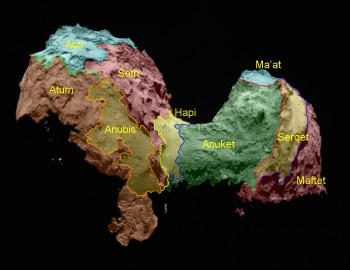
Regional map of Comet 67P/C-G. Credit: ESA/Rosetta/MPS for OSIRIS Team MPS/UPD/LAM/IAA/SSO/INTA/UPM/DASP/IDA
.
Another smooth region, Anubis, dominates the view on the large lobe, partly surrounded by the more complex terrains of Atum.
The small lobe features the sharp ridge between Serqet and Anuket and, towards the right, hints of the rough terrains of Maftet are also in sight.
The original 1024 x 1024 image is provided below:
.

“CRESCENT COMET” – COMETWATCH 15 AND 16 APRIL
Just when we think we have seen Comet 67P/C-G from all possible angles under the current illumination conditions, a striking view like this presents itself.
.
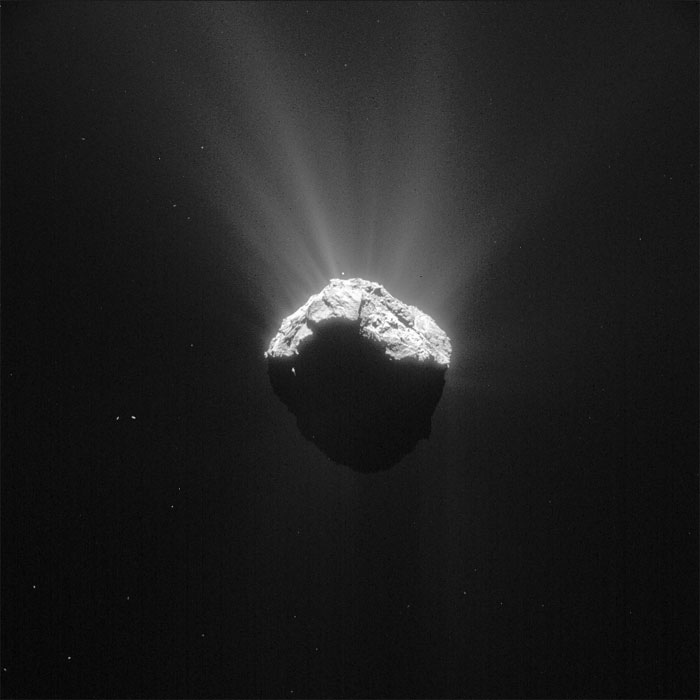
Comet 67P/C-G on 15 April 2015 at 11:55 UT. Credits: ESA/Rosetta/NAVCAM – CC BY-SA IGO 3.0
.

Cometwatch 15 April in context. Credits: ESA/Rosetta/NAVCAM – CC BY-SA IGO 3.0
.
The image was captured on 15 April 2015 by Rosetta’s Navigation camera from a distance of 162 km from the comet centre. The resolution is 14 m/pixel and the image measures 14 km across. It has been processed to bring out the incredible detail of the comet’s activity streaming away from the nucleus.
The previous two CometWatch entries were also acquired on 15 April and today’s image fits into the sequence nicely, captured just before midday spacecraft time, a little over two hours after Monday’s entry.
Under the viewing conditions at this time, the comet appears largely in shadow, with the ‘underside’ of the comet’s large lobe beautifully silhouetted against the background glow of activity that surrounds the nucleus.
A hint of the small comet lobe can also be made out in the distance.
A second image, captured around 13 hours later on 16 April helps to provide the context. The slight difference in viewing geometry and illumination brings shadowed Imhotep into the light, making it easier to identify the neighbouring regional boundaries.
.
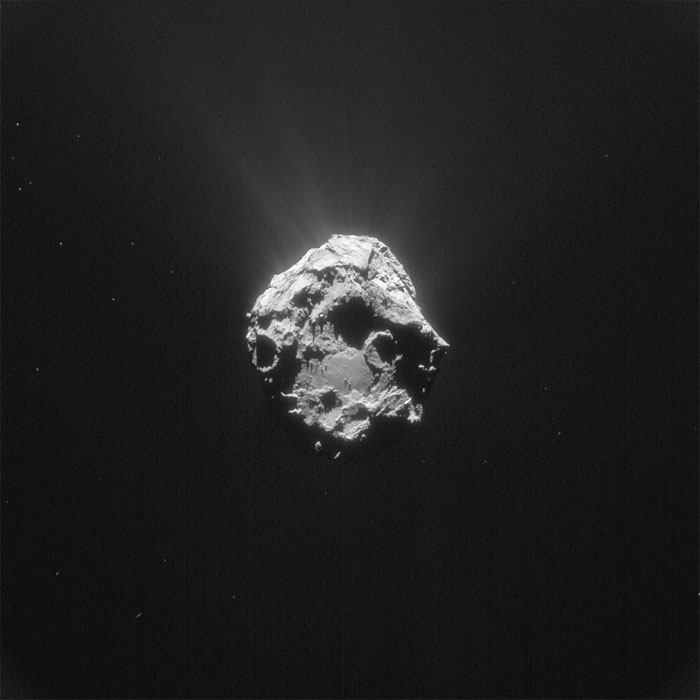
Comet 67P/C-G on 16 April 2015 at 01:06 UT, from a distance of 146 km. The image scale is 12 m/pixel and the image measures 13 km across. Credits: ESA/Rosetta/NAVCAM – CC BY-SA IGO 3.0
.
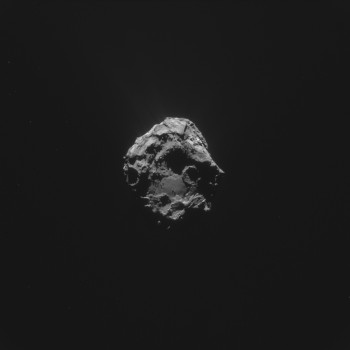
Quelle: ESA
-
Update: 24.04.2015
-
COMETWATCH 18 APRIL
This view of Comet 67P/C-G was taken on 18 April from a distance of 101 km from the comet centre.
.

Comet 67P/C-G on 18 April 2015 from a distance of 101 km. Credits: ESA/Rosetta/NAVCAM – CC BY-SA IGO 3.0
.
The resolution is 9 m/pixel and the image measures 9 km across. The image has been processed to bring out details of the comet’s activity while still maintaining details on the nucleus.
In this orientation we see the comet’s small lobe towards the left, with the rugged cliffs of Hathor standing out.
On the large lobe the transition between Apis and Ash can be seen, the images presented earlier this week providing the context. Once again, Imhotep is cast in shadow, with just a hint of the large lobe’s outline silhouetted against the comet’s background activity.
The original 1024 x 1024 pixel image is provided below:
.

Quelle: ESA
-
Update: 27.04.2015
.
COMETWATCH 20 APRIL
This view of Comet 67P/C-G was taken on 20 April from a distance of 128 km from the comet centre.
The resolution is 11 m/pixel and the image measures 11 km across. The image has been processed to bring out details of the comet’s activity, which can be seen all around the illuminated side of the nucleus.
.

Comet 67P/C-G on 20 April 2015 from a distance of 128 km. Credits: ESA/Rosetta/NAVCAM – CC BY-SA IGO 3.0
.
Particularly striking is the straight-edged shadow cast by the comet’s large lobe across the 'neck' of the small lobe.
Details of the comet’s surface can also be seen. On the small lobe, shadows accentuate the steep cliffs of Hathor and this region’s transition into Anuket in the distance, and the much smoother Hapi in the foreground.
On the large lobe, the outlines of a number of circular and quasi-circular structures are visible in Ash.
The original 1024 x 1024 pixel image is provided below:
.
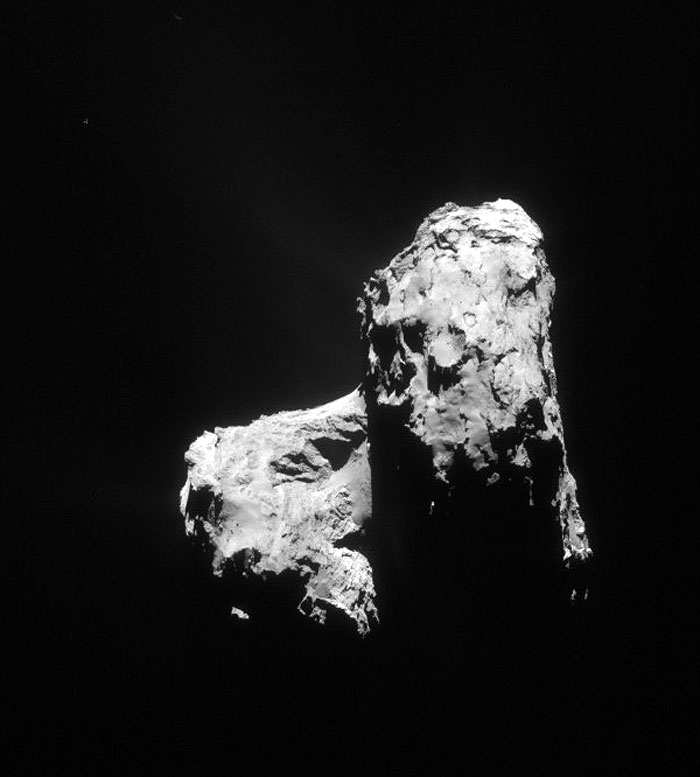
Quelle: ESA
.
Update: 29.04.2015
-
MAJOR RELEASE OF NAVCAM IMAGES: 800 TO 30 KM
Today marks a major release from the Rosetta downlink and archive groups of detailed images of Comet 67P/Churyumov-Gerasimenko taken by Rosetta’s Navigation Camera, or NAVCAM. The 1297 images, which can be accessed via the Archive Image Browser, were acquired between 1 August and 23 September. This corresponds to the final approach of Rosetta to the comet, its arrival at a distance of 100 km on 6 August and its transition to a global mapping phase at 30 km. It was during these two months that mapping and characterisation of the comet’s surface began, and Philae’s candidate landing sites were proposed, analysed and finally selected.Shown above is a taste of the images you can find in this latest release. The images are single frame 1024 x 1024 pixel images and cover the period 1-22 August. In late August the imaging scheme changed from single frame images to 2 x 2 rasters, once the spacecraft’s proximity to the comet meant that the nucleus overfilled the NAVCAM field of view. This transition is seen in the latest data release, and below is a montage of just a few incredible single-frame images you can find in the Browser from this period:
.

Comet close-ups from the 30 km mapping period are now available in the NAVCAM Archive Image Browser. Click to enter! Credits: ESA/Rosetta/NAVCAM – CC BY-SA IGO 3.0
Coming next month
At the end of May even more detailed images will be released in the NAVCAM image browser and in the Planetary Science Archive. This release will again cover two months – this time October and November – and therefore cover the transition from the 30 km mapping phase down to just 10 km from the comet’s surface. In addition, the image release will cover the exciting period leading up to and during the landing, including the days in which Philae was operating on the surface of Comet 67P/C-G.
In the meantime, we look forward to seeing what you do with the August-September image set; if you make movies, mosaics, shape models and so on, we’d be delighted if you share links in the comments box below.
Quelle: ESA
-
Update: 4.05.2015
-
COMETWATCH 26 APRIL
This image of Comet 67P/Churyumov-Gerasimenko was taken on 26 April and not only presents an incredible view of the comet’s activity, but also shows off some interesting new views of the comet’s nucleus.
.

Comet 67P/C-G on 26 April 2015 from a distance of 98 km. The image has been processed to bring out details of the comet's activity. Credits: ESA/Rosetta/NAVCAM – CC BY-SA IGO
The image was taken by Rosetta’s NAVCAM from a distance of 98 km from the comet centre. The scale at this distance is 8.4 m/pixel and the image measures about 8.6 km across.
One eye-catching region lies in the foreground of the comet’s large lobe, which appears as a smoother swath of material sandwiched between more rugged surrounds. This is also evident in an image taken last month from a different angle, and as such it is interesting to compare the two.
Perhaps even more captivating is the intricate pattern of activity streaming in all directions from both the small and the large lobe. While many distinct bands of dust extend towards the edge of the field of view, more diffuse regions of activity can be made out close to the nucleus. This makes for a particularly beautiful scene along the boundary between the shadowed and sunlight region on the large lobe close to the neck.
In addition, several straight-edged shadows can be seen as a result of the small lobe casting a shadow onto the comet’s neck and large lobe. The silhouette of the underside of the large lobe is also just visible.
The original 1024 x 1024 pixel image is provided below:
.

Quelle: ESA
.
Update: 8.05.2015
.
COMETWATCH 28 APRIL
Today’s CometWatch entry is a single frame NAVCAM image obtained on 28 April, from a distance of 151 km from the centre of Comet 67P/Churyumov-Gerasimenko. At this distance, the resolution is 13 m/pixel; the image has been cropped to 11 km (the original frame, provided at the end of the post, measures 13 km across).
.

Cropped and processed single frame NAVCAM image of Comet 67P/C-G taken on 28 April 2015 from a distance of 151 km to the comet centre. Credits: ESA/Rosetta/NAVCAM – CC BY-SA IGO 3.0
.
With the large lobe of the comet in the foreground and the small lobe in the background, this image provides another interesting view on the smooth area on the large lobe that was featured prominently in CometWatch 26 April. In today’s image, this portion of the comet, consisting of parts of the Aker and Khepry regions, appears as a bright, slab-like feature pointing upwards. Behind it, on the small lobe, are parts of the rougher Bastet region.
The image has been processed to enhance the activity of 67P/C-G, with jets of material outflowing gloriously from the sunlit parts of both lobes. A bright, diffuse spot in front of the dark underside of the comet’s large lobe, home to the Imhotep region, seems to be strongly suggestive of activity there, too. From this distance, however, it is not immediately possible to know whether this is linked to the dust jet caught emanating from this side of the comet by Rosetta’s OSIRIS camera a few weeks ago.
The original 1024 x 1024 image is provided below:
.
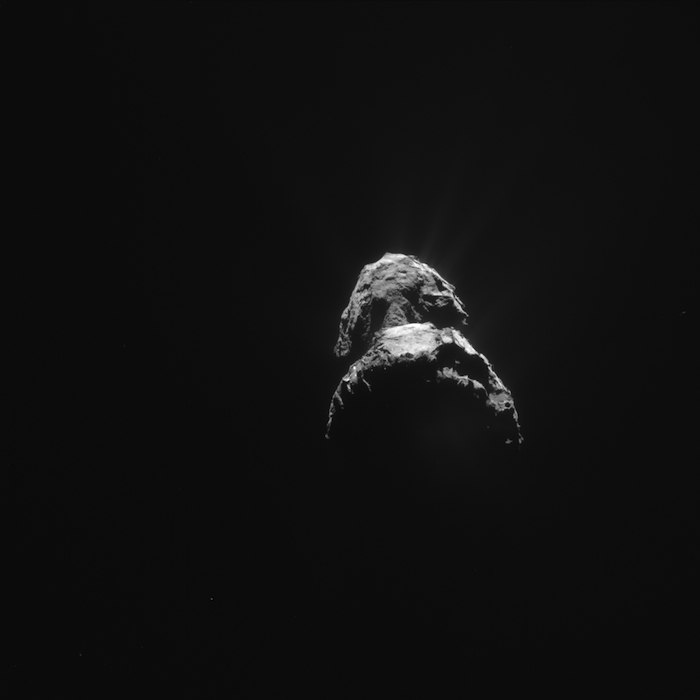
Quelle: ESA
-
Update: 11.05.2015
.
ROSETTA AND PHILAE FIND COMET NOT MAGNETISED
This new result was just presented at EGU2015 and is published in Science Express today. The text is mirrored from our news story on the main ESA web portal.
Measurements made by Rosetta and Philae during the probe’s multiple landings on Comet 67P/Churyumov-Gerasimenko show that the comet’s nucleus is not magnetised.
.

Complementary data collected by the Rosetta Plasma Consortium fluxgate magnetometer (RPC-MAG) on board the orbiter (top) and the Rosetta Lander Magnetometer and Plasma Monitor (ROMAP) on board the lander (bottom) have been used to investigate the magnetic properties of Comet 67P/Churyumov-Gerasimenko.
The pictures on the left indicate the positions of the two instruments on the orbiter and lander, respectively. The graph on the right shows the data collected by the instruments. Note that to better see the complementary nature of the two data sets, the RPC-MAG data have been shifted up by 10 nT.
The data shown cover the period immediately prior to the second touchdown of Philae at 17:25 GMT (onboard lander time) on 12 November 2014. The first touchdown was recorded at 15:34 GMT, the collision at 16:20 GMT, and the final touchdown at 17:31 GMT.
.
Studying the properties of a comet can provide clues to the role that magnetic fields played in the formation of Solar System bodies almost 4.6 billion years ago. The infant Solar System was once nothing more than a swirling disc of gas and dust but, within a few million years, the Sun burst into life in the centre of this turbulent disc, with the leftover material going into forming the asteroids, comets, moons and planets.
The dust contained an appreciable fraction of iron, some of it in the form of magnetite. Indeed, millimetre-sized grains of magnetic materials have been found in meteorites, indicating their presence in the early Solar System.
This leads scientists to believe that magnetic fields threading through the proto-planetary disc could have played an important role in moving material around as it started to clump together to form larger bodies.
But it remains unclear as to how crucial magnetic fields were later on in this accretion process, as the building blocks grew to centimetres, metres and then tens of metres across, before gravity started to dominate when they grew to hundreds of metres and kilometres in scale.
Some theories concerning the aggregation of magnetic and non-magnetic dust particles show that the resulting bigger objects could also remain magnetised, allowing them to also be influenced by the magnetic fields of the proto-planetary disc.
.

Magnetic field data from ROMAP on Philae, combined with information from the CONSERT experiment that provided an estimate of the final landing region, timing information, images from Rosetta’s OSIRIS camera, assumptions about the gravity of the comet, and measurements of its shape, have been used to reconstruct the trajectory of the lander during its descent and subsequent landings on and bounces over the surface of Comet 67P/Churyumov-Gerasimenko on 12 November 2014. The times are as recorded by the spacecraft; the confirmation signals arrived on Earth 28 minutes later.
Initially, Philae was seen to rotate slowly during the descent to Agilkia. It landed and then bounced, rotating significantly faster as the momentum of the internal flywheel was transferred to the lander. It collided with a cliff 45 minutes later, then tumbled, flying above the surface for more than an hour longer, before bouncing once again and coming to a stop a few metres away, a few minutes later.
The position of the first touchdown point at Agilkia is very well determined from direct images, but the locations of the possible cliff collision depends on the ballistic model used, while the general location marked for the subsequent second and third touchdowns at Abydos come from the CONSERT measurements. Thus, these latter positions represent preliminary and approximate locations only.
The heights above the surface assume a reference sphere centred on the centre of mass of the comet and with a radius of 2393 m reaching first touchdown point.
.
Because comets contain some of the most pristine materials in the Solar System, they offer a natural laboratory for investigating whether or not these larger chunks could have remained magnetised. However, detecting the magnetic field of comets has proven difficult in previous missions, which have typically made rapid flybys, relatively far from comet nuclei.
It has taken the proximity of ESA’s Rosetta orbiter to Comet 67P/Churyumov-Gerasimenko, and the measurements made much closer to and at the surface by its lander Philae, to provide the first detailed investigation of the magnetic properties of a comet nucleus.
Philae’s magnetic field measuring instrument is the Rosetta Lander Magnetometer and Plasma Monitor (ROMAP), while Rosetta carries a magnetometer as part of the Rosetta Plasma Consortium suite of sensors (RPC-MAG).
Changes in the magnetic field surrounding Rosetta allowed RPC-MAG to detect the moment when Philae was deployed in the morning of 12 November 2014.
Then, by sensing periodic variations in the measured external magnetic field and motions in its boom arm, ROMAP was able to detect the touchdown events and determine the orientation of Philae over the following hours. Combined with information from the CONSERT experiment that provided an estimate of the final landing site location, timing information, images from Rosetta’s OSIRIS camera, assumptions about the gravity of the comet, and measurements of its shape, it was possible to determine Philae’s trajectory.
The mission teams soon discovered that Philae not only touched down once at Agilkia, but also came into contact with the comet’s surface four times in fact – including a grazing collision with a surface feature that sent it tumbling towards the final touchdown point at Abydos. This complex trajectory turned out to be scientifically beneficial to the ROMAP team.
“The unplanned flight across the surface actually meant we could collect precise magnetic field measurements with Philae at the four points we made contact with, and at a range of heights above the surface,” says Hans-Ulrich Auster, co-principal investigator of ROMAP and lead author of the results published in the journal Science and presented at the European Geosciences Union General Assembly in Vienna, Austria, today.
.

Magnetic field data collected by Philae’s ROMAP instrument immediately before (top) and after (bottom) the cliff collision at 16:20 GMT on 12 November 2014 (onboard spacecraft time), between the first and second touchdowns. Height above the surface is plotted on the x-axis and magnetic field strength on the y-axis. Therefore time runs left-to-right for the ascent (lower) plot, but right-to-left for the descent (upper) plot.
The measurements (crosses) are compared with a hypothetical model (solid line) assuming a slightly magnetised surface. Also included is the strength of and variation in the external field, namely the influence of the solar wind interplanetary magnetic field near the comet nucleus.
At distances of 10 m or greater from the surface, the surface component would be very weak, leaving just the external field, as measured. But closer to the surface, the comet’s own field should increase and dominate. That is not seen, therefore the data suggest that at scales of greater than one metre (the resolution of the instrument), the comet is not magnetised.
.
The multiple descents and ascents meant that the team could compare measurements made on the inward and outward journeys to and from each contact point, and as it flew across the surface.
ROMAP measured a magnetic field during these sequences, but found that its strength did not depend on the height or location of Philae above the surface. This is not consistent with the nucleus itself being responsible for that field.
“If the surface was magnetised, we would have expected to see a clear increase in the magnetic field readings as we got closer and closer to the surface,” explains Hans-Ulrich. “But this was not the case at any of the locations we visited, so we conclude that Comet 67P/Churyumov-Gerasimenko is a remarkably non-magnetic object.”
Instead, the magnetic field that was measured was consistent with an external one, namely the influence of the solar wind interplanetary magnetic field near the comet nucleus. This conclusion is confirmed by the fact that variations in the field that were measured by Philae closely agree with those seen at the same time by Rosetta.
“During Philae’s landing, Rosetta was about 17 km above the surface, and we could provide complementary magnetic field readings that rule out any local magnetic anomalies in the comet’s surface materials,” says Karl-Heinz Glassmeier, principal investigator of RPC-MAG on board the orbiter and a co-author of the Science paper.
If large chunks of material on the surface of 67P/Churyumov-Gerasimenko were magnetised, ROMAP would have recorded additional variations in its signal as Philae flew over them.
“If any material is magnetised, it must be on a scale of less than one metre, below the spatial resolution of our measurements. And if Comet 67P/Churyumov-Gerasimenko is representative of all cometary nuclei, then we suggest that magnetic forces are unlikely to have played a role in the accumulation of planetary building blocks greater than one metre in size,” concludes Hans-Ulrich.
“It’s great to see the complementary nature of Rosetta and Philae’s measurements, working together to answer this simple, but important ‘yes-no’ question as to whether the comet is magnetised,” says Matt Taylor, ESA’s Rosetta project scientist.
Quelle: ESA
5475 Views
